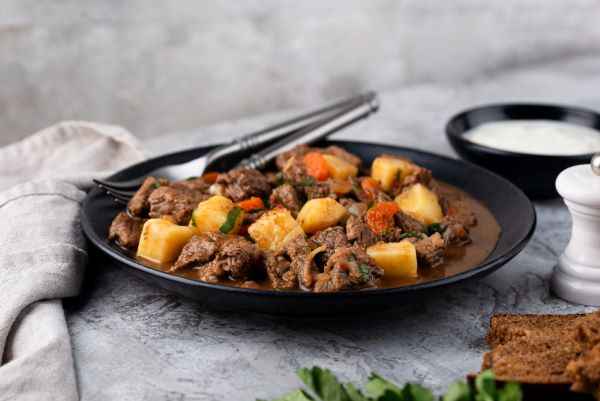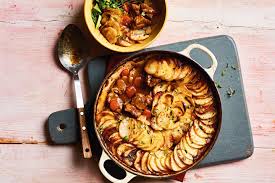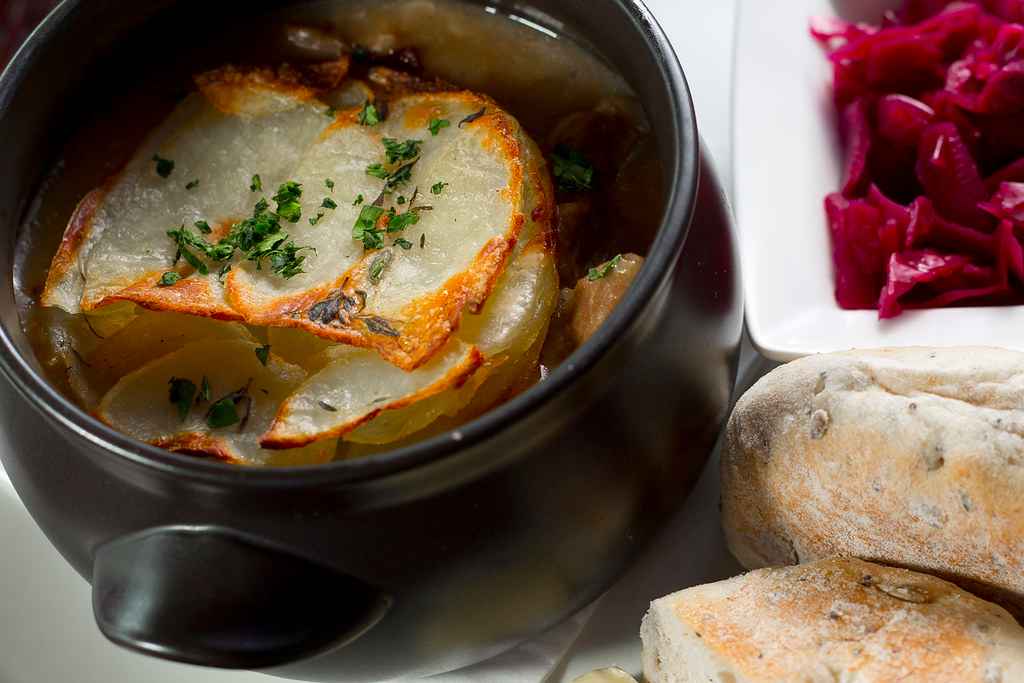The Lancashire hotpot is a well-known British classic from the northwest of England.
This comforting dish is about simplicity. It consists of sweet lamb, sliced onions, and buttery layers of potatoes slowly cooked until tender.
A quintessential one-pot wonder from the Industrial Revolution, Lancashire hotpot was initially created as a quick meal for hard-working men; it is still a proud bastion of British cooking that can offer the world its secrets without fuss.
This is how to prepare this classic dish.
Contents
Ingredients
Of course, to make an authentic Lancashire hotpot, recipe you will need:
- 1 kilogram (2.2 pounds) lamb shoulder or neck, bone-in for the best flavour
- Two onions, peeled and sliced thin
- 3-4 Carrots, sliced (not a must but usually added)
- Thinly sliced waxy potatoes – 750g [about 1.5 lbs] (Maris Piper is good)
- 2 cups (500 ml) lamb or beef stock
- Kosher salt and freshly cracked black pepper, to taste
- Whole fresh thyme sprigs (optional to enhance the smell)
- Two bay leaves
- 50g (approx 3 tbsp) of Butter or drippings (in the olden days, they used beef drippings)
Optional Ingredients
For more flavour: 100g/1/2 cup sliced mushrooms
1-2 tsp Worcestershire sauce or vinegar for some acidity
Instructions and steps to make classic Lancashire Hotpot

Step 1: Prepare Ingredients
- Prep the Lamb: Chop the lamb into pieces (1-2 in.)—this adds some fat flavour. Getting bone-in lamb gives you a little further flavour; the bone is easy to discard if it has been cooked.
- Cut the Vegetables: Slice the onions, carrots, and potatoes into thin slices. Use a mandoline to make bite-sized pieces.
Step 2: Layer the Ingredients
- Layer the Lamb: Place half the lamb in the bottom of a large ovenproof casserole or Dutch oven measuring at least two qt. After that, season with salt and pepper, thyme (optional), and sprinkle if used.
- Add Onions and Carrots: 2. Place a layer of onions and carrots on the lamb. Put some bay leaves and, if using, mushrooms for extra flavour.
- Layer Potatoes: Layer half of the potatoes over onions and carrots. Season with salt and pepper.
- Layer Again: Repeat the lamb, onions and carrots, followed by a last layer of potatoes. Layer the potato slices neatly and overlapping for the top layer, as this will be viewed.
Step 3: Add Stock and Butter
- Pour in the Stock: Carefully pour in the stock around the sides of the dish, not completely submerging the top layer of potatoes so that they may brown and crisp.
- Add Butter to the Top Layer: Either dot melted Butter or cut into little chunks and scatter them over the top layer of spuds. That will help them turn golden while cooking.
Step 4: Slow Cooking
- Preheat the Oven: Prepare your oven and set the temperature to 160 degrees Celcius (320 degrees F)
- Cover and Cook: Bake for 1.5 to 2 hours. The lamb also gets fork-tender after many hours in the slow cooker, and there’s time for all those flavours to combine.
- Uncover for Crisping: If you want to crisp the top. uncover it after about 1.5 to 2 hours. Raise the roaster to 180 degrees Celsius (350 degrees F) and singe for 30-45 twinkles, or until the top layer of potatoes is browned.
Step 5: Check and Serve
- Check for Tenderness: The potatoes should be soft, and the angel should be chopstick-tender. However, you can place the dish under the broiler for a few minutes, if the top is not browned to your liking.
- Serving: Let the hotpot settle for a few minutes before serving directly from the pot.
Tips for a Perfect Lancashire Hotpot
- Choosing the Lamb: Shoulder or neck cuts are traditionally used as they offer the most tenderness. Bone-in cuts lend flavour as they cook, enhancing the stew’s richness.
- Waxy Potatoes: Waxy potatoes (such as Maris Piper or Yukon Gold) keep their shape well while cooking and form distinct layers. If you prefer a creamier texture, you can also use floury potatoes like Russets; they tend to disintegrate more.
- Slow and Steady Cooking: Slow cooking is critical. Though we may be inclined to rush the process, the low and slow allows flavours to bloom.
- Optional Seasoning: Optional seasonings such as Worcestershire sauce or once other vinegar are added to the stock if you wish for depth. They provide a touch of acidity to balance the richness of the lamb.
- Don’t Overcrowd Layers: Strive for thin, uniform layers to ensure all the ingredients are properly cooked. Anything that causes the cookware to be crowded will cause stuff not to get cooked evenly.
Serving Suggestions

Lancashire hotpot is usually accompanied by pickled red cabbage or fresh steamed greens such as kale or broccoli.
The tangy flavour from the cabbage balances out the fatty lamb. Another option is with crusty bread for that savoury juice.
Final Thoughts
More than mere sustenance, the Lancashire hotpot recipe is a dish in history.
Packed with tender lamb, endless layers of earthy potatoes (we love a good potato), and combined in the most effortless hotpot fashion,
one might possess a one-pot meal that genuinely needs no introduction when it comes to home because, by principle, this hotpot is so simple, so perfectly home-style cooking at its best.


